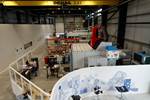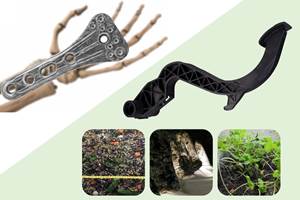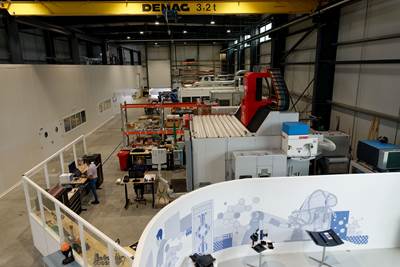Detroit Auto Show
2007 NAIAS exhibition spotlights new composites applications.
The 2007 North American International Auto Show, held Jan. 13-21 at the Cobo Conference/Exhibition Center in Detroit, Mich., once again served as the leading showcase for production and concept vehicle introductions from domestic and international OEMs. A number of hybrid vehicles were featured, reflecting the industry's increasing awareness of environmental concerns, such as global warming. Among them was General Motors' Volt concept car, with batteries and electric motors capable of running up to 40 miles (64 km) on a single six-hour charge before its small gasoline engine kicks in to generate sufficient electricity to power the motors until the car's batteries can be recharged. Because many people drive less than this distance most days, it is possible that a tank of fuel could last a very long time, provided the car's owner remembers to plug the vehicle in at night. Notable for the number of plastic and composite components used on the concept, the Volt may or may not see production (if yes, possibly by 2010) and could differ significantly in terms of material use (see тАЬRelated Content,тАЭ at left).
Concurrent with the event, the Automotive Composites Alliance (ACA) held a daylong reception at a venue adjacent to Cobo Hall, featuring composite components and the chance to learn more about the materials and methods used to produce them. SMC is still the predominant composite material used on production automobiles, and a number of material and process advances have been made in materials and processing, which are covered in more detail in the feature article on p. 30. One new SMC application highlighted by the ACA was the hood for the 2008 model Dodge Viper. Although previously made of SMC, the hood was restyled during a mid-cycle upgrade of the vehicle to accommodate an 8.4L V-10 engine with larger cylinder bores, a modification that enables production of more than 600 hp. Molded by Meridian Automotive Systems (Allen Park, Mich.), the hood now includes an integrally molded front scoop and larger louvers. The outer skin is standard low-profile, Class A SMC, and the bonded inner panel is a low-density (1.3 g/cm3) structural SMC. Other recent SMC introductions include a hood for the Lincoln Navigator, molded by Continental Structural Plastics (formerly Budd Plastics, Troy, Mich.), and vinyl ester valve covers for the 13L diesel engines in Mack Truck and Cummins heavy trucks.
An interesting new hybrid composite introduction was the "Divide-N-Hide"trunk divider, available on some Nissan Sentra models. This flip-down panel, also molded by Meridian Automotive Systems, is installed about 12 inches/300 mm behind the back seat, creating a compartment that can be used to stow seldom-used or valuable items. Meridian director of engineering Tyler Hardy says the divider comprises two bonded panels. The forward panel (visible when the back seat is folded down) and latch housing must meet dynamic impact loads caused by sudden stops or accelerations, and are molded from structural 30 percent glass SMC with molded-in color. The assembly's trunk side panel is a polypropylene/flax fiber composite with molded-on carpet.
Directed fiber preforming is increasing in structural applications says Keith Bihary, automotive sales manager for Molded Fiber Glass Cos. (MFG, Ashtabula, Ohio) and the 2007 ACA chairman. Termed "positive glass placement"by MFG, the process yields components with less mechanical property variance than SMC, thanks mainly to robotic placement of the fibers prior to resin addition and compression molding. The Saturn Sky, Dodge Viper, Pontiac Solstice and Chevrolet Corvette all use structural components molded via the process. On the Corvette Z06, the floor panels and wheelhouses are made using the process and incorporate carbon fiber for 40 percent weight savings. Bihary says that, despite the current shortage of aerospace grade carbon fiber, interest in carbon is growing, in part because MFG engineers have developed techniques to use more readily available commercial-grade (large tow) carbon fiber.
Related Content
Bioabsorbable and degradable glass fibers, compostable composite parts
ABM Composite offers sustainable options and up to a 60% reduction in carbon footprint for glass fiber-reinforced composites.
Read MoreWatch: A practical view of sustainability in composites product development
Markus Beer of Forward Engineering addresses definitions of sustainability, how to approach sustainability goals, the role of life cycle analysis (LCA) and social, environmental and governmental driving forces. Watch his “CW Tech Days: Sustainability” presentation.
Read MoreJEC World 2024 highlights: Glass fiber recycling, biocomposites and more
CW technical editor Hannah Mason discusses trends seen at this year’s JEC World trade show, including sustainability-focused technologies and commitments, the Paris Olympics amongst other topics.
Read MoreBio-based, fire-resistant composites become mainstream
Projects use Duplicor prepreg panels with highest Euroclass B fire performance without fire retardants for reduced weight, CO2 footprint in sustainable yet affordable roofs, high-rise façades and modular housing.
Read MoreRead Next
Plant tour: Daher Shap’in TechCenter and composites production plant, Saint-Aignan-de-Grandlieu, France
Co-located R&D and production advance OOA thermosets, thermoplastics, welding, recycling and digital technologies for faster processing and certification of lighter, more sustainable composites.
Read More“Structured air” TPS safeguards composite structures
Powered by an 85% air/15% pure polyimide aerogel, Blueshift’s novel material system protects structures during transient thermal events from -200°C to beyond 2400°C for rockets, battery boxes and more.
Read MoreComposites end markets: New space (2025)
Composite materials — with their unmatched strength-to-weight ratio, durability in extreme environments and design versatility — are at the heart of innovations in satellites, propulsion systems and lunar exploration vehicles, propelling the space economy toward a $1.8 trillion future.
Read More









